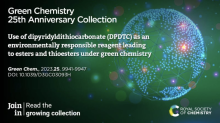Synthesis of bioactive molecules from 5-hydroxymethylfurfural vía Passerini multicomponent reaction (ACS Green and Sustainable Chemistry Summer School, GSCSS - 2024)
The pharmaceutical industry is currently experiencing increasing demand for small-molecule drugs. However, a significant portion of the raw materials used in drug production are fossil-based, originating from crude oil. This reliance on non-renewable resources presents major challenges, particularly in the context of global environmental crises such as climate change, greenhouse gas emissions, and dwindling oil reserves.



